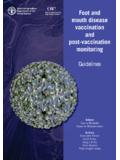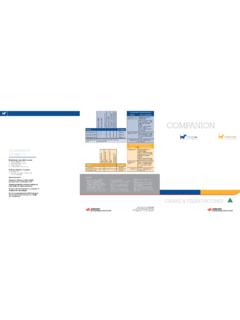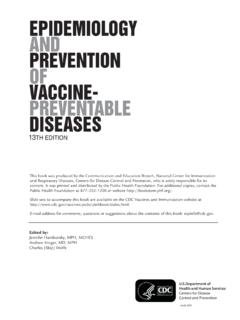Transcription of Strategies for the Control and Investigation of Varicella ...
1 _____. Strategies for the Control and Investigation of Varicella Outbreaks 2008 . _____. Adriana S Lopez, MHS and Mona Marin, MD. National Center for Immunization and Respiratory Diseases Centers for Disease Control and Prevention Summary Following implementation of the one-dose Varicella vaccination program in the United States in 1995, Varicella vaccination coverage has steadily increased and the number of Varicella cases has decreased. However, despite the increasing use of Varicella vaccine, outbreaks of Varicella have continued to occur, even in settings with high vaccination coverage. Thus, in June 2006, a second dose of Varicella vaccine was added to the routine childhood vaccination program to assist, in part, with outbreak prevention and Control .
2 To improve existing knowledge about the epidemiology of Varicella and to have a basis for refining Varicella vaccination policy, it is important to monitor and investigate Varicella outbreaks. These guidelines for the Control and Investigation of such outbreaks were developed by the Centers for Disease Control and Prevention's (CDC's) National Center for Immunization and Respiratory Diseases (NCIRD) with input from state and local public health departments. Public health officials should implement appropriate responses to reports of Varicella cases to determine if an outbreak exists and, if so, to evaluate its scope and implement Control measures appropriate to the outbreak setting. 2. Table of Contents I. Introduction 5.
3 II. Background 6. III. Reporting 7. IV. Case Definition and Classifications 7. V. Laboratory Diagnosis of Varicella 8. VI. Definitions 9. VII. Recommendations 10. A. A Single Varicella Case as a Potential Source for an outbreak 12. B. Confirm the outbreak 12. C. Identify Cases 12. D. Implement Varicella Control Measures 12. Notification of outbreak 12. Exclusion or Isolation of Case-Patients 13. Management of herpes zoster case-patients as potential 13. sources for Varicella outbreaks Isolation precautions 13. Management of Persons without Evidence of Immunity 14. Identification of persons without evidence of immunity 14. Vaccination of persons without evidence of immunity 14. Management of persons who refuse vaccination 15.
4 Management of persons with contraindications to the 15. Varicella vaccine Management of persons with rash developing within 15. 42 days after vaccination E. Conduct Case Investigation 16. Information to Obtain from Persons with Varicella 16. F. Establish Surveillance for Additional Cases 17. Components of Varicella Surveillance in an outbreak Setting 17. G. Analyze and Interpret the Data 17. Interpretation of the Data 17. H. Develop a Plan for Preventing Future Varicella Outbreaks 18. VIII. Vaccine 19. IX. Conclusion 19. X. References 20. 3. XI. Appendix A: Sample Varicella outbreak reporting worksheet 24. XII. Appendix B: Sample exposure letters 25. XIII. Appendix C: Sample survey to identify cases of Varicella in setting 26.
5 XIV. Appendix D: Sample letters of notification of Varicella outbreak 28. XV. Appendix E: Sample Varicella case Investigation form 30. XVI. Appendix F: Useful formulas for investigations of Varicella outbreaks 35. XVII. Appendix G: Sample Varicella surveillance worksheet 36. 4. I. INTRODUCTION. Before licensure of the Varicella vaccine, Varicella was a common childhood disease, causing about 4 million cases, including an average of 10,500 hospitalizations and 105 deaths, each year [1 3]. The Varicella vaccine was licensed for use in the United States in 1995 and was recommended by the Advisory Committee on Immunization Practices (ACIP) and the American Academy of Pediatrics (AAP) for routine use in healthy children 12 18 months of age and for older susceptible children and adults [4, 5].
6 In 2006, national 1-dose Varicella vaccination coverage among children 19 35 months of age was 89% [6] and Varicella -related morbidity and mortality had declined significantly following implementation of the 1-dose Varicella vaccination program. The incidence of disease decreased 90% between 1995 and 2005, with the greatest decline in children and adolescents [7]. National Varicella hospitalizations declined 88% during 1994 2002 [8], and age-adjusted mortality rates decreased 66% from 1990 1994 to 1999 2001, with the greatest decline (92%) in children 1 4 years of age [3]. Recommendations for the prevention of Varicella were updated in 2006 to include a routine two-dose schedule for children; the first dose is recommended at 12 15 months of age and the second dose at 4 6 years of age, with catch-up vaccination for all persons without evidence of immunity to Varicella and for one-dose vaccine recipients [9].
7 One of the rationales for the second-dose recommendation was to reduce the number of Varicella outbreaks because of the burden they caused on public health personnel, schools, and families. Therefore, tracking outbreaks through existing case-based surveillance will help states and CDC monitor the impact of this new recommendation. As overall disease incidence declines, the risk for exposure to Varicella -zoster virus (VZV) decreases, leading to susceptible (unvaccinated and vaccinated) children aging into adolescence and adulthood. Although the total number of Varicella cases is declining, a shift of the remaining Varicella disease burden to middle school years is being observed. In 1995, the median age of Varicella infection ranged from 3-5 years in vaccinated persons and from 5-6 years in unvaccinated persons.
8 By 2005, the median age increased to 6 8 years in vaccinated persons and 13 19 years in unvaccinated persons [7]. As the age of infection increases, Varicella outbreaks may occur more frequently in middle schools, high schools, and colleges. Implementation of recommended catch-up vaccination for older children and adolescents and Varicella vaccination requirements for day care, elementary, middle, and high school, and college entry will prevent increasing susceptibility and subsequent outbreaks in these age groups [9]. Achieving high immunization levels in day care centers, schools, and colleges is important because transmission of infectious diseases like Varicella is facilitated by the increased contact rates among students [10].
9 In the United States, school requirements have proven to be an extremely effective strategy for achieving high vaccination coverage among school-aged children [11]. As of September 2007, 48 states and the District of Columbia had implemented requirements that children entering day care or school must have received either one dose of Varicella vaccine or have other evidence of immunity to Varicella . Twenty-six states have requirements for entry to middle or high school [CDC unpublished data, 12]. States are in the process of transitioning to the two-dose Varicella vaccination school entry requirements for elementary schools; the number of states with college entry requirements is not known. Investigations of Varicella outbreaks in schools and other settings in the vaccine era will improve our knowledge of the epidemiology of Varicella , assess virus transmission patterns, describe disease burden and risk factors for severe Varicella , provide estimates of Varicella 5.
10 Vaccine effectiveness for two versus one dose of vaccine, and identify risk factors for vaccine failure. In addition, monitoring the number and size of Varicella outbreaks will help to assess impact of the second-dose recommendation. These data will facilitate the development and refinement of appropriate public health interventions to Control and prevent future Varicella outbreaks and further reduce Varicella morbidity and mortality. II. BACKGROUND. Varicella (chickenpox) is the disease that results from primary infection with the Varicella -zoster virus (VZV). It is a highly contagious rash illness that is transmitted from person to person by direct contact with patients with either Varicella or herpes zoster (HZ) or by airborne spread (from respiratory secretions or aerosolized vesicular fluid from skin lesions).
















